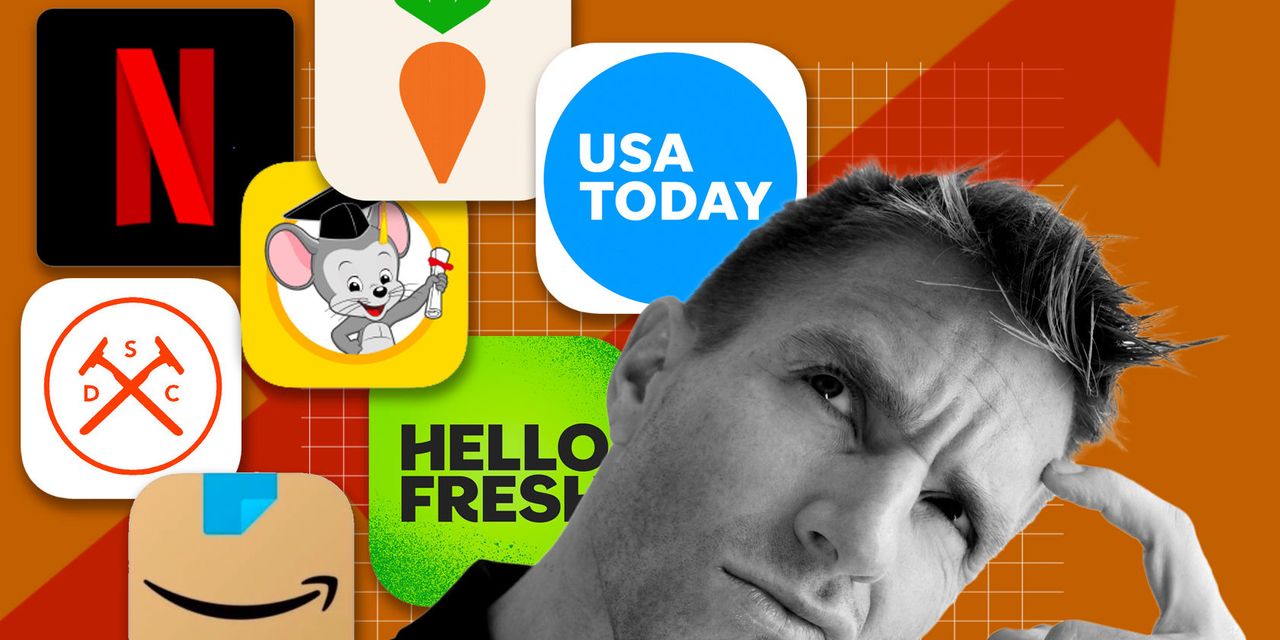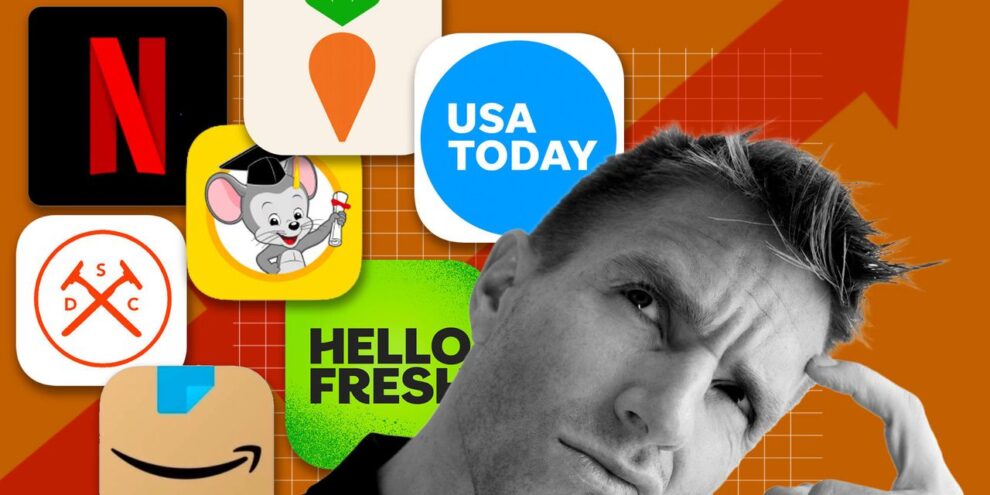
Subscriptions often start out small, at just a few dollars a month. But they add up quickly, and if you’re not vigilant, the true monthly cost can sneak up on you.
In the past week alone, I was surprised to see $154 coming out of my bank account for three newspaper subscriptions. Two were subscriptions whose prices had jumped up after I had signed up under cheap introductory offers months ago.
Another one was the annual charge on a subscription that I didn’t even realize I still had. I signed up for it at least four years ago, and when a friend asked me recently if I still had it to help him access an article, I said unfortunately, no. I was wrong. I had been paying for it all along.
All of these subscriptions were on auto-pay, which contributed to my appalled facial expression when I saw the charges in my account.
The question of which subscriptions to cancel grows even more fraught when I think about the ones I signed up for with the intention of improving myself, like the language-learning app that was going to be my ticket to learning Spanish.
What’s worse, the month is just starting and these are not my only subscriptions. I have more lined up, waiting to reintroduce themselves to my bank account in the upcoming weeks — Spotify SPOT, +1.45% for $9.99, Netflix NFLX, +1.25% for $9.99 and a few others.
Subscriptions were once mainly used for newspapers and streaming services, but today the business model covers all kinds of products and services, from clothing to food to language learning services, makeup, and more.
Quick, how much do you spend per month on subscriptions?
Perhaps because they’re all around us, subscriptions seem to be fading into the background of our financial awareness. On average, people in the U.S. underestimate their monthly subscription costs by $133, a May survey by C+R Research found. People estimated they spent an average of $86 on subscriptions per month, when in reality, they spent $219. Less than a quarter of the 1,000 survey respondents correctly guessed their monthly subscription costs within $25.
The survey pointed to auto-pay as part of the reason why people’s estimate is often off. Nearly three quarters of respondents set all of their monthly subscriptions to auto-pay; 42% reported they had forgotten about a recurring monthly service that they no longer use. Generation Z consumers were the most likely to say they were paying for a subscription even after they had forgotten about it, and baby boomers were the least likely, the survey found.
But there’s a better way to manage subscription costs, and MarketWatch talked to financial advisers for tips on how to get smart about your subscriptions. Here are some action steps to getting your subscription costs under control.
Take a hard look at aspirational subscriptions
Among the subscriptions I paid for in the past month, some I still use actively, and some I had forgotten about. Those are the easy ones to decide whether to keep or cancel. But it’s hard to make a decision about subscriptions that felt like personal resolutions when I signed up for them.
For example, I have paid for Lupa, a Spanish-learning app, continuously for more than a year, but I have seldom opened it. Renewing the $6 student subscription fee every month feels like renewing my vows of becoming trilingual. When my Puerto Rican best friend lightly roasted me for not getting her Spanish joke despite my self-proclaimed Spanish literacy, I reassured myself thinking about the Lupa subscription I paid for every month, even though I had hardly made the effort of opening it. Should I keep this subscription?
“From a self-preservation point of view, the prudent answer is no,” said William Huston, chief investment officer at Bay Street Capital Holdings, an investment firm based in Palo Alto, Calif., after hearing the story of my aspirational subscription.
He said he related to the feeling on a personal level and said he had a similar experience on Peloton PTON, +3.07%, the once red-hot biking subscription that prompts users to work out. He canceled it partly because he realized he hated exercising and was avoiding it. Any subscription that’s not being used on a regular basis should be cut, he said.
As for signing up for learning apps, Daniel Raynaud, CEO of Jiveworld, SPC , the maker of Lupa, recommended comparing reviews of different apps before buying, and seeking out apps that let you try out all of their features during a trial period, as well as ones that offer easy canceling and refund options.
One key question people should ask themselves before signing up for a learning app, Raynaud said: “Am I prepared to put in the effort to achieve the goals I have?”
Even if a few dollars a month seems like a small price to pay to achieve a major life goal, it’s important to be clear-eyed about the financial impact, financial advisers told me.
If you’re having a hard time deciding which subscriptions to cut, start with the ones you haven’t used in the past month, said Mark Schrader, a financial planning thought leader at TIAA.
“If you didn’t use the service last month, ask yourself whether you will use it this month,” he said. If that’s unlikely, it may make sense to cancel, even if it seems affordable — the $10 monthly charge quickly adds up to an annual cost of $120.
“That’s $120 a year that’s no longer available for other goals, such as retirement savings, paying down debt or an emergency fund that may give you more flexibility in the future,” Schrader told me. As he put it — people should look further down the road.
Look at your monthly transactions more than once a month
Using a third-party app to monitor all of your expenses is a good way to start off the subscription management journey, financial advisers said. There are quite a lot of them these days, some of which specifically track recurring charges so you can easily see your subscription costs, and some of which are designed for overall budgeting.
“I recommend reviewing these regularly and cancelling the services you aren’t enjoying. This can cut down on leakage in your budget and help you direct your dollars in a more intentional manner,” Schrader said.
But be vigilant in choosing such apps, said Rick J. Nott, Senior Wealth Advisor with LourdMurray in Beverly Hills, Calif. Some money management apps are free, but they can present privacy risks because users often hand over their personal banking information.
Ask: Is this subscription adding value to my life?
When one notices that they are paying a few different vendors for similar services within the same month, then it’s time to ask yourself hard questions, such as whether those services offer very similar content and whether one could replace another, Huston said.
When deciding which ones to keep, sort your subscriptions into two categories: value-adding or entertainment and discretionary, Huston said. It’s a “need versus wants” question, he said.
As an example, Huston said for him personally, he would consider subscriptions to three newspapers as value-adding.
“You can even say those are a self-improvement-related type of subscription, ” Huston said. “Although there’s a meaningful cost to them, I can see on a day-to-day basis, weekly basis, that it’s a value added in my life by having the subscription.”
On the other hand, Huston said people may want to take a hard look at maintaining long-term subscriptions designed to deliver the latest wardrobe trends. “There’s nothing wrong with that for a period of time,” he said, but at some point a clothing subscription may not feel as essential as one in the “value-adding” category.
Ask: Is this subscription financially beneficial to me?
The “value-adding” category looks different from person to person, financial advisors said. It comes down to whether the subscription brings convenience to a person’s lifestyle, said Savon Gibson, Sr., founder and CEO from Gibson Financial Planning + Empire Consulting.
For instance, he said, for someone like a doctor, a meal subscription plan might free them up from spending time cooking and give them a little breathing room in a tight schedule.
“Time is money, you are paying for convenience, you are paying to have your time,” Gibson said. If a subscription saves him an hour or two of time, taking himself as an example, he may be able to use that time to do something that develops new business opportunities, which would make the costs of the subscription worth it.
When it comes to separating wants from needs, consumers appear to view media and entertainment subscriptions (think video streaming services like Netflix) as a need. Those subscriptions have the lowest unsubscribe rates, said Guy Marion, CEO and founder of the customer retention tool Brightback, which is now owned by Chargebee. Among all types of services, “box of the month” subscriptions — which include food, apparel, and beauty boxes — have the highest unsubscribe rates.
Among all different kinds of services, streaming media services are still the most subscribed ones, with almost all respondents (98%) reporting that they have at least one streaming service subscription, according to a Brightback survey conducted in 2021, before Netflix announced it had lost 200,000 subscribers in the first quarter of 2022.
Know your monthly budget and see if subscriptions can provide cheaper substitutes
Know what you spend each month on certain expense categories, then think about whether a subscription can help you save money on that expense.
“If you track your budget, you can think about whether you consider the subscriptions part of your utilities or part of your monthly entertainment,” Schrader said.
A subscription to a streaming service can be an economical substitute for other entertainment options, such as seeing movies in theaters or going to live shows, he said. Even if you only use the streaming service twice a month, that might still be cheaper entertainment than going to a movie theater, where you may spend money on peripherals like popcorn, candy and soda.
Be smart about trial offers
Free or discount trial offers are great for letting you test drive various subscriptions, but it’s easy to let the trial period expire and suddenly find yourself paying full price. To avoid this, set reminders on your phone or mark your calendar to remind yourself to unsubscribe before the trial period ends, Nott said.
“So if it’s a 30-day window, I’ll set it up for 20 days or 25 days,” Nott said. “So I have a lot of time just in case there’s something going on in my life.”
Also, read the fine print and make sure you know what the actual full subscription price is before you commit. $1 for four weeks sounds great, but you should make sure the full subscription cost fits into your monthly budget, Nott said.
Be proactive about discounts
If your job requires you to stay up to date on current affairs, Schrader said, ask your boss if there’s a group subscription you can access for the newspapers that help you do your job.
It can even help to contact the subscription company directly if it’s a small outfit and ask for a cheaper price, Huston said. There’s a chance that those smaller companies will listen, he said, as it might be more profitable to retain existing customers who already enjoy the service than investing in resources to attract more subscribers.
You can also actively seek out discounts for certain groups, said Raynaud. “If you are a student, veteran, or in some helping profession, contact the app developer to see if any discounts are available, if that information is not readily available on their website,” said Raynaud. “There’s no harm trying.”
Prepare for FOMO
At the end of the day, try to focus on your overall financial priorities and ignore the fear of missing out. Sometimes not having certain subscriptions can be an emotional experience, as pointed out by Schrader: “If you decide to redirect subscription dollars to other goals you may have to fight against FOMO when others talk about the newest shows or other services they use.”
“But you need to focus on your goals,” Schrader said.






